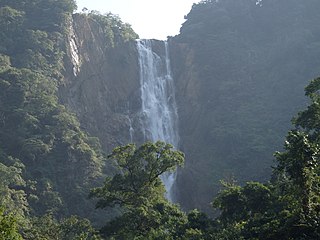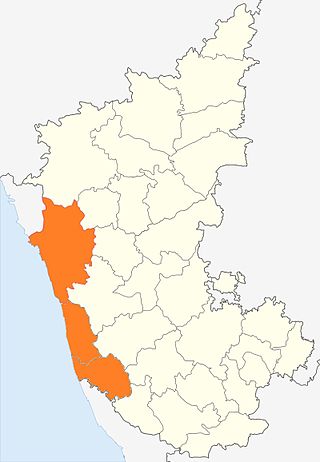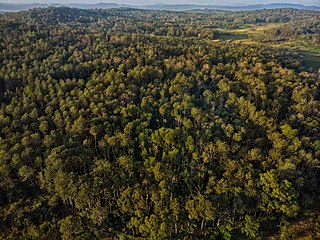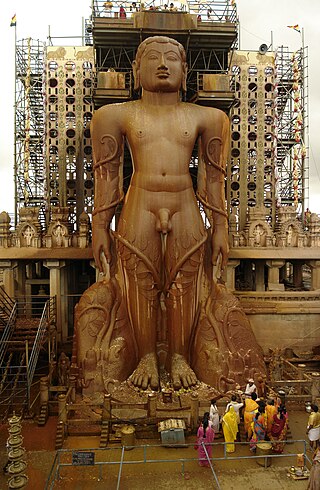Related Research Articles

Karnataka is a state in the southwestern region of India. It was formed as Mysore State on 1 November 1956, with the passage of the States Reorganisation Act, and renamed Karnataka in 1973. The state is bordered by the Lakshadweep Sea to the west, Goa to the northwest, Maharashtra to the north, Telangana to the northeast, Andhra Pradesh to the east, Tamil Nadu to the southeast, and Kerala to the southwest. With 61,130,704 inhabitants at the 2011 census, Karnataka is the eighth-largest state by population, comprising 31 districts. With 15,257,000 residents, the state capital Bangalore is the largest city of Karnataka.

Uttara Kannada is a district in the Indian state of Karnataka. It is a major coastal district of Karnataka, and is the third largest district in Karnataka. It is bordered by the state of Goa and Belagavi districts to the north, Dharwad District and Haveri District to the east, Shivamogga District, and Udupi District to the south, and the Laccadive Sea to the west.

Shimoga, officially Shivamogga, is a city and the district headquarters of Shimoga district in the central part of the state of Karnataka, India. The city lies on the banks of the Tunga River. Being the gateway for the hilly region of the Western Ghats, the city is popularly nicknamed the "Gateway of Malnad". The population of Shimoga city is 322,650 as per 2011 census. The city has been selected for the Smart Cities project, standing in the fourth position in the state and 25th in the country as of November 2020.

Belgaum, officially known as Belagavi, is a city in the Indian state of Karnataka located in its northern part along the Western Ghats. It is the administrative headquarters of the eponymous Belagavi division and Belagavi district. The Government of Karnataka has proposed making Belgaum the second capital of Karnataka alongside Bangalore, hence a second state administrative building Suvarna Vidhana Soudha was inaugurated on 11 October 2012.

Kanara or Canara, also known as Karavali, is the historically significant stretch of land situated by the southwestern Konkan coast of India, alongside the Arabian Sea in the present-day Indian state of Karnataka. The subregion comprises three civil districts, namely: Uttara Kannada, Udupi, and Dakshina Kannada. Kassergode was included prior to the States Reorganisation Act.

Malnad is a region in the state of Karnataka, India. Malenadu covers the western and eastern slopes of the Western Ghats mountain range and is roughly 100 kilometers in width. It includes the districts of Uttara Kannada, Chikmagalur, Chamarajanagar, Udupi, Belgaum, Dakshina Kannada, Hassan, Kodagu, Shimoga. The region experiences heavy annual rainfall of 1,000–3,800 millimetres ; it includes the village of Agumbe, which receives the highest annual rainfall in Karnataka.

Kodachadri is a mountain peak with dense forests in the Western Ghats in South India, 78 km from Shimoga. Kodachadri is the highest peak in Shivamogga district. It is declared as natural heritage site by the Karnataka Government. and it is 13th highest peak of Karnataka.

Kali Tiger Reserve is a protected area and tiger reserve. It is located in Uttara Kannada district, in Karnataka, India. The park is a habitat of Bengal tigers, black panthers and Indian elephants, amongst other distinctive fauna. The Kali River flows through the tiger reserve and is the lifeline of the ecosystem and hence the name. The tiger reserve is spread over an area of 1300 square kilometres.

Sirsi is a city and a taluk headquarter in Uttara Kannada district of Karnataka state in India. It was also known as Kalyana Pattana during the Sonda Dynasty. It is a tourist destination with evergreen forest and waterfalls and is also a commercial centre. The main businesses around the city are mostly subsistence and agriculture-based. Areca nut or betel nut, locally known as Adike, is the primary crop grown in the nearby villages, making it one of the major trading centres for areca nut. The region is also known for spices such as cardamom, pepper, betel leaves, and vanilla. The major food crop is paddy.

Karnataka, the sixth largest state in India, has been ranked as the third most popular state in the country for tourism in 2014. It is home to 507 of the 3600 centrally protected monuments in India, second only to Uttar Pradesh. The State Directorate of Archaeology and Museums protects an additional 752 monuments and another 25,000 monuments are yet to receive protection.

Ghat Roads are access routes into the mountainous Western and Eastern Ghats, mountain ranges of the Indian subcontinent. These roads are remarkable feats of engineering, and most were constructed during the British Raj. Ghat Roads were built to connect to the hill stations established in the mountains for residents to avoid summer heat. They generally served to connect coastal areas with the upper Deccan Plateau.

Sri Sri Raghaveshwara Bharathi (originally, Harish Sharma), is an Indian religious guru and the present maṭhadhis (Guru) of Shri Ramachandrapura Mutt, Hosanagara in Shimoga district in the Indian state of Karnataka. He is the 36th maṭhadhis of Shri Ramachandrapura Math. He took sannyasa from Jagadguru Sri Ragavendra Bharati Mahaswamiji the previous maṭhadhis, in April 1994. He is a follower of Advaita Vedanta.
Karnataka is a state in the southern part of India. It was created on 1 November 1956, with the passing of the States Reorganisation Act. Karnataka is bordered by the Arabian Sea to the west, Goa to the north-west, Maharashtra to the north, Telangana and Andhra Pradesh to the east, Tamil Nadu to the south-east, and Kerala to the south-west. The state covers an area of 74,122 sq mi (191,976 km2), or 5.83% of the total geographical area of India. It comprises 30 districts. Kannada is the official language of Karnataka and as per the 2011 census is the mother tongue of 66.5% of the population. Various ethnic groups with origins in other parts of India have unique customs and use languages at home other than Kannada, adding to the cultural diversity of the state. Significant linguistic minorities in the state in 2011 included speakers of Urdu (10.8%), Telugu (5.8%), Tamil (3.5%), Marathi (3.4%), Hindi (3.2%), Tulu (2.6%), Konkani (1.3%) and Malayalam (1.3%).
The Halakki-Vokkalu are an indigenous tribe of Karnataka, India. They are found predominantly in Uttara Kannada district and are distinct from Vokkaligas.

Gavali is a small village located in the Belgaum district, Karnataka state in India, southwest of the city of Belgaum. The village is surrounded by forests, waterways and falls, which are subject to illegal mining, removal of medicinal plants and deforestation.
Shri Gangadharendra Saraswati, officially Shreemajjagadguru Shankaracharya Shri Gangadharendra Saraswati Swamij, is pontiff (Guru) of Shri Sonda Swarnavalli Mutt, Sirsi, Karnataka, India. He is the 54th Guru of this mutt. He took sannyasa and ordination from Shri Jayendra Saraswathi Mahaswamiji of Kanchi Matha which is known as Kanchi kamakoti Peetham. He is a follower of Advaita Vedanta.
Ambaragudda is a hill, covering 250 hectares located in Western Ghats village named "Marati" near Kodachadri in Sagara taluk, in the Indian state of Karnataka. It is covered with rainforests. Mining operations have drawn protests. The Karnataka government declared it as a natural heritage site of Western Ghat region in 2009.
.
References
- 1 2 "10 ancient trees named arboreal heritage". Deccan Herald (Bangalore). 4 August 2010. Retrieved 12 January 2015.
- ↑ "Andolan seeks restoration of ban on mining at Ambargudda". The Hindu . 17 August 2005. Archived from the original on 17 January 2015. Retrieved 12 January 2015.
- ↑ Pinto, Stanley. "Task force concerned". The Times of India. Retrieved 5 October 2012.